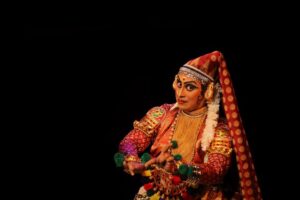A Kathak maestro, she is a well-known name that appears on the top in the list of eminent classical dancers of India. Her wonderful performances have left the people awestruck. Her teacher was none other than the famous Late Pandit Birju Maharaj. Well, I am talking about the great Indian Kathak dancer Shovana Narayan.

Shovana Narayan has given an entirely new dimension to dancing. She is an accomplished dancer, whose facial expressions complements her dance and makes her performance simply outstanding. Her choreographic works have not only been well acclaimed in India, but are also highly praised overseas.
Recently, she organised Lalit Arpan, a festival with a wonderful theme and message, evoking people to think the true meaning of freedom, independence, liberation and sovereignty. Post the show I spoke to the creative dancer and choreographer. Excerpts from the interview:
How did the concept of Lalit Arpan festival come about?
When we were discussing the theme of this year’s festival, I mentioned that the term swatantrata had several dimensions. Besides political freedom it also includes freedom of expression, thought, word, action and choice. But in the exercise of freedom, there is an associated cautionary note namely of knowing one’s boundaries, of accountability, keeping values intact, and self-dignity, etc. The idea was approved by all our committee members and thus Swatantrata aur Swabhiman came about.
Lalit Arpan had a brilliant mix of poetry and storytelling along with your dance, please tell me more about this amalgamation?
The genre of dance enactment first came about in 1990 when late philosopher, Prof Ramchandra Gandhi, grandson of Mahatma Gandhi wrote and narrated the script. This was Mohan and Rambha based on an incident recorded by Mahatma Gandhi in his autobiography. Thus choosing the same format, Roop Vidroop was enacted. In such dance enactments, the clarity of a story line or inner thoughts as well as the abhinaya and pure dance and classical music elements get equal treatment, each complimenting the other. The common thread is dance abhinaya. Thus the text is enacted through dance gestures with bhavas and rasas, and where needed, certain pieces are elaborated with pure dance patterns, Roop Vidroop was a heart wrenching performance on the trauma of an acid attack survivor.
Why did you chose this theme for your performance?
Too many such instances have been happening all round. How many of us realise that face or a body, in a way, is a window to the identity of a being. And if that is suddenly disfigured, there is the victim’s inner trauma as to who she is; for she is not what she used to be or was she was born with. The perpetrator had wanted either her death or to make life a living hell. The latter is true in case she survives for she now becomes a social outcaste by all – her family, her children – her neighbours- by society at large. Shunned by all, she is forced into social isolation. She faces social discrimination because of her disfigured face and body. Life becomes a living hell. Traumatised, pained, and anguished, in a state of depression she questions herself as to whether death was better than the living tortuous hell that she has been forced into.
In other words, are we, as society allowing her to live with self-respect and dignity and not pushing her further curtailing her freedom of expression, movement, living, etc? It is not political freedom but it is a freedom from prejudices and biases and freedom to live with head held high that such victims are asking for.
You had other artists like Prabal Gupta and Ratnav Theatre Artists to dance for the festival too, what made you include them in the show?
Some of us had seen this most evocatively powerful production of Prabal’s at Bangalore and therefore we also wanted to introduce audiences of Delhi to it. He performed Kshaatra Baalaa, a tribute to those great women of our country who had lost their husbands during protecting our nation and its boarders. Similarly, keeping the spirit of the festival, dance drama Lallan Miss by Ratnav Theatre Artists was selected. It is the story of a transgender fighting to live a life in dignity and with social acceptance, inclusion and understanding. This play brought out several features and rituals in the lives of transgenders, which the so-called normal society are not even aware of. Some of these rituals makes one realise their own inner turmoil and dilemma as such a body had been foisted on them by birth (and not by choice). And for no fault of theirs, they were punished first by their own families and then by society. Why are they denied the ‘freedom’ to live like anyone else?
You always come up with interesting concepts, what next after Lalit Arpan?
Well, I usually do not plan things in advance, I trust and follow my heart all the time, let us see what the heart says and where does it lead me! For now, I am thrilled that our show Lalit Arpan was received beautifully and the message Swatantrata aur Swabhiman reached out as expected.
Sandip Soparrkar holds a doctorate in world mythology folklore from Pacifica University USA, an honorary doctorate in performing arts from the National American University, He is a World Book Record holder, a well-known Ballroom dancer and a Bollywood choreographer who has been honored with three National Excellence awards, one National Achievement Award and Dada Saheb Phalke award by the Government of India. He can be contacted on sandipsoparrkar06@gmail.com